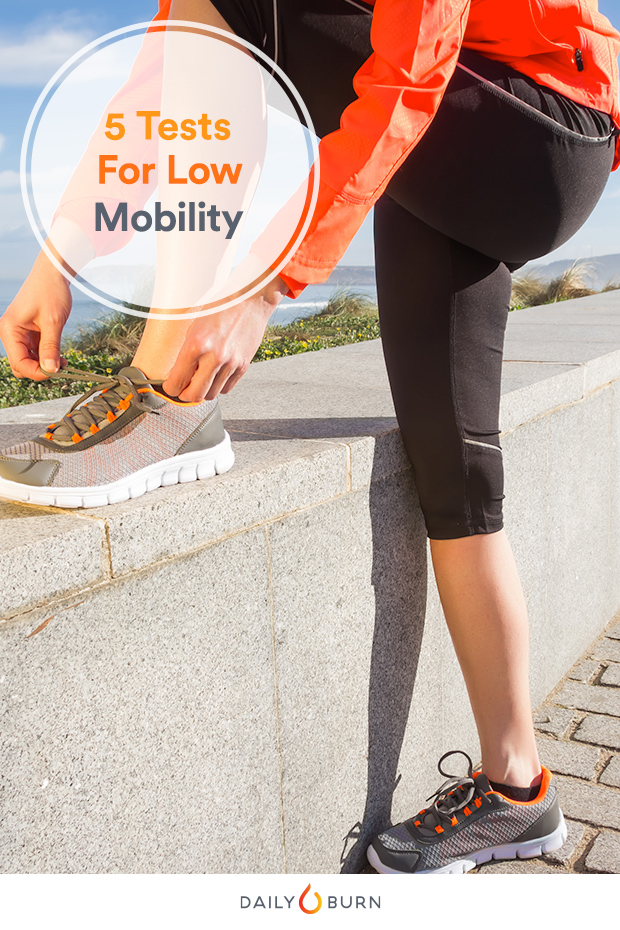
For most of us, mobility is a fitness afterthought. But, when it comes to improving our athletic performances and our overall health, mobility is king. 5 everyday tasks that reveal low mobility…
But, when it comes to improving our athletic performances and our overall health, mobility is king. When we are able to move our bodies through their full range of motion, we can run faster and get better results with strength training. (And who doesn’t want that?)
Great mobility can shore up muscle imbalances, alleviate nagging muscle pains, and prevent injury, explains trainer Jacquelyn Brennan, C.S.C.S., co-founder of Mindfuel Wellness in Chicago. On the flip side, poor mobility — a common side effect of desk jobs — can make us unconsciously compensate for our limited range of motion. The resulting improper exercise form can cause certain muscles to overwork, and ultimately, this can lead to injury and chronic pain, Brennan says.
Not sure about how your range of motion stacks up? Put yourself to the test with these five everyday tasks that reveal low mobility — and find out how to loosen up for awesome fitness gains.
5 Simple Tests for Low Mobility
1.The “Shoe Laces” Test
How It’s Done: Sit down in a chair and extend one leg in front of you on the floor. Keeping your leg straight, hinge at the hips to reach down and tie your shoelaces.
What It Reveals: If you are unable to touch your toes without bending your knee, you likely have poor flexibility in your hamstrings. This could lead to back issues down the line, says certified corrective exercise specialist Tara Romeo, C.S.C.S., assistant director at the Professional Athletic Performance Center in New York. Difficulty or discomfort in the hip joint could indicate that your hips may be tight.
Loosen Up: If you have tight hamstrings (most people do), focus on stretching your hamstrings and lower back, Romeo suggests. You can also improve hip mobility by performing deep bodyweight squats or any of these five hip stretches, Brennan says.
2. The “In Reverse” Test
How It’s Done: When backing your car into the driveway or parallel parking, physically turn your head and neck to look behind you.
What It Reveals: Turning to look behind you requires mobility in the chest, neck and upper back muscles, Brennan says. So if you can’t look behind you without rotating at the waist, you likely have significant tightness in at least one of those three areas.
Loosen Up: Try these posture exercises to dynamically stretch and correct muscle imbalances between the muscles in your upper back, chest and neck.
3. The “Back Scratch” Test
How It’s Done: Reach your hand behind your head and across your shoulders as if you’re trying to scratch an itch in the middle of your opposite shoulder blade. Then try to scratch the same “itch” by reaching down and across your upper back. Repeat with the opposite arm.
What It Reveals: Not being able to reach your opposite shoulder with a behind-the-back reach points to tightness in the shoulder joint — with muscles including your lats, traps, deltoids and pecs contributing, Romeo says. It’s common for people to have less mobility in their dominant side due to increased muscle mass.
Loosen Up: Get out to foam roller to work your upper back and shoulders, Brennan says. Chest stretches can also help here, Romeo says.
4. The “Against the Wall” Test
How It’s Done: Whenever you find yourself leaning up against a wall (while waiting in line, etc.) try standing tall and see if you can stand with your head, shoulders, middle back and tail bone all pressed into the wall at the same time.
What It Reveals: If you can get everything but your head against the wall, we’ve got some bad news. You have a tight chest and, likely, a weak back due to hours spent slumped over a computer, Brennan says.
Loosen Up: Implement wall stretching into your routine. Stand against a wall with your head, shoulders, and back as close to the wall as possible. Then, reach both of your arms back and try to slide your arms up and down against the wall, sort of like a bent-arm snow angel against a wall, she says.
5. The “Proposal” Test
How It’s Done: Get down on one knee and, with your front foot pointing straight forward and planted flat on the floor, lean forward so that your knee extends a few inches over your toes. If your heel comes off the ground or your foot turns inward or outward, stop the movement.
What It Reveals: Not being able to keep your heel planted firmly on the floor throughout this movement indicates tight calves and poor ankle mobility. It can lead to ankle and knee pain if not addressed, Romeo says.
Loosen Up: Try this calf stretch for greater ankle mobility.
Originally written for DailyBurn.com